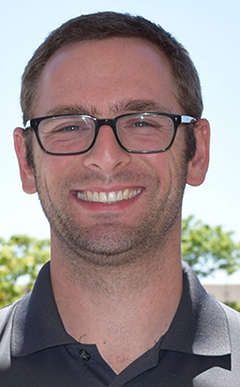
Joseph Hoover, Ph.D., of the University of New Mexico Center for Native American Environmental Health Equity Research, uses modeling tools to help address tribal communities’ concerns about exposure to contaminants from abandoned mines and other potentially toxic sites.
Hoover started working with the center first as a postdoctoral fellow, Career Development Investigator, and later as co-lead of the Community Engagement Core (CEC). Now, he co-directs the center with Johnnye Lewis, Ph.D., and Debra Mackenzie, Ph.D.
“Co-leading the CEC allowed me to take on new responsibilities and learn from mentors, including my co-lead, Dr. Melissa Gonzales, and Dr. Lewis,” said Hoover. “That experience also illustrated the variety of ways my background in geography could contribute to the center and allowed me to operate in both the social science world and the biomedical world.”
Hoover is now grateful for the opportunity to mentor other early-career scientists and graduate students at the center.
Linking Environmental Exposure to Health Outcomes
Hoover leads a project that uses sophisticated mapping technologies to examine the relationship between exposure and disease on the Navajo, Crow, and Cheyenne River Indian Reservations. For example, Hoover and colleagues used advanced geospatial and computational models to develop an environmental risk map that illustrates areas at highest risk of exposure to contaminants from abandoned uranium mines.
The project originally focused on heavy metals found in mine waste. The team recently added contaminants from trash dumping and burning.
“Most Indian Reservations have limited or no solid waste disposal options, so people end up burning their trash. That process releases a lot of different harmful chemicals, including heavy metals, PAHs, and more.” Hoover explained. “We are updating our geospatial models to also make predictions about what kind of materials are released from these trash burning sites and where they will end up.”
The team is also using silicone wristbands, which community members wear for a week, to explore connections between trash dump contaminants and exposures to chemicals.
Engaging Tribal Communities, Building Local Capacity
One of Hoover’s many responsibilities as co-director is maintaining and strengthening relationships with tribal communities to ensure the success and sustainability of the center’s projects. Those efforts were particularly critical during the height of theCOVID-19 pandemic, when travel to reservations was limited.
“I’ve spent a lot of time on the phone or on Zoom, coordinating meetings, checking with our partners, and conducing trainings for people in the community who can do some of the fieldwork and collect environmental data themselves,” said Hoover. “In some ways, these procedures have enhanced our ability to build community capacity and conduct environmental health research.”
To learn more about Hoover’s NIEHS past research, see this 2018 Grantee Highlight.


